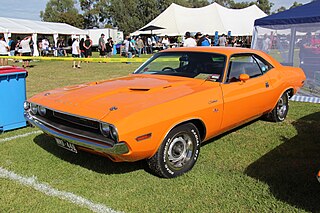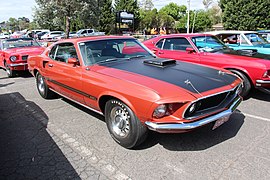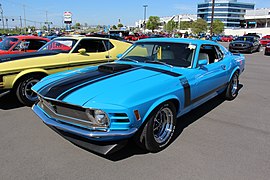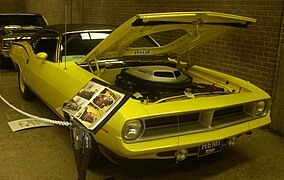
The Pontiac GTO is a front-engine, rear-drive, two-door, four-passenger automobile manufactured and marketed by the Pontiac division of General Motors over four generations from 1963 until 1974 in the United States — with a fifth generation made by GM's Australian subsidiary, Holden, for the 2004 through 2006 model years.

Muscle car is a description according to Merriam-Webster Dictionary that came to use in 1966 for "a group of American-made two-door sports coupes with powerful engines designed for high-performance driving." The Britannica Dictionary describes these as "an American-made two-door sports car with a powerful engine."

The Plymouth Road Runner is a mid-size car with a focus on performance built by Plymouth in the United States between 1968 and 1980. By 1968, some of the original muscle cars were moving away from their roots as relatively cheap, fast cars as they gained features and increased in price. Plymouth developed the Road Runner to market a lower-priced, basic trim model to its upscale GTX.

The Pontiac Firebird is an American automobile built and produced by Pontiac from the 1967 to 2002 model years. Designed as a pony car to compete with the Ford Mustang, it was introduced on February 23, 1967, five months after GM's Chevrolet division's platform-sharing Camaro. This also coincided with the release of the 1967 Mercury Cougar, Ford's upscale, platform-sharing version of the Mustang. The name "Firebird" was also previously used by GM for the General Motors Firebird series of concept cars in the 1950s.

The Dodge Challenger is the name of three different generations of automobiles produced by American automobile manufacturer Dodge. However, the first use of the Challenger name by Dodge was in 1959 for marketing a "value version" of the full-sized Coronet Silver Challenger.

Pony car is an American car classification for affordable, compact, highly styled coupés or convertibles with a "sporty" or performance-oriented image. Common characteristics include rear-wheel drive, a long hood, a short decklid, a wide range of options to individualize each car and use of mass-produced parts shared with other models. The popularity of pony cars is largely due to the launch of the Ford Mustang in 1964.

The Plymouth Barracuda is a two-door pony car that was manufactured by Chrysler Corporation from 1964 through 1974 model years.

The Pontiac V8 engine is a family of overhead valve 90° V8 engines manufactured by the Pontiac Division of General Motors Corporation between 1955 and 1981. The engines feature a cast-iron block and head and two valves per cylinder. Engine block and cylinder heads were cast at Saginaw Metal Casting Operations then assembled at Tonawanda Engine before delivery to Pontiac Assembly for installation.

The Ford Mustang Mach 1 is a performance-oriented option package of the Ford Mustang muscle car, originally introduced in August 1968 for the 1969 model year. It was available until 1978, returned briefly in 2003, 2004, and most recently in 2021.

The Chrysler Hemi engines, known by the trademark Hemi or HEMI, are a series of American V8 gasoline engines built by Chrysler with overhead valve hemispherical combustion chambers. Three different types of Hemi engines have been built by Chrysler for automobiles: the first from 1951 to 1958, the second from 1964 to 1971, and the third from 2003 to 2024. Although Chrysler is most identified with the use of "Hemi" as a marketing term, many other auto manufacturers have incorporated similar designs. The engine block and cylinder heads were cast and manufactured at Indianapolis Foundry.

Specialty Equipment Market Association (SEMA) of the automobile aftermarket was formed in 1963 by Paul Schiefer, Roy Richter, Ed Iskenderian, Els Lohn, Willie Garner, Bob Hedman, Robert E. Wyman, John Bartlett, Phil Weiand Jr, Al Segal, Dean Moon, and Vic Edelbrock Jr. Now it consists of 6,383 companies worldwide, bringing together aftermarket manufacturers, original equipment manufacturers (OEM), media, car dealers, specialty equipment distributors, installers, retailers, and restoration specialists.

The Dodge Charger (1966), also known as Dodge Charger (B-body), is a mid-size automobile that was produced by Dodge from 1966 to 1978, and was based on the Chrysler B platform.
Ford Mustang variants are the various versions of the Ford Mustang car, modified either by its manufacturer Ford Motor Company or by third-party companies. Ford and several third-party companies have offered many modified versions of the highly popular Mustang since its creation in 1964 in order to cater to specific portions of the marketplace outside of the mainstream. High-performance enthusiasts seek more powerful, sharper handling, sports cars such as the Shelby Mustang, the Ford Mustang Mach 1, and variants made by Roush Performance and Saleen, while collectors and purists seek limited production and alternate or nostalgic styling, such as is commonly found on many commemorative editions. Still, others were made purely for experimental concepts such as the McLaren M81 and the Ford Mustang SVO, which later influenced production model design. Most variants include both performance upgrades, and unique cosmetic treatments that are typically minimal to maintain the familiar appearance of a stock Mustang. Although most of these Mustang variants were aimed at enthusiasts, an exception was the Special Service Package which was designed specifically for law enforcement. Race variants include the FR500, Boss 302 and Boss 429.

The Boss 429 Mustang is a high-performance Ford Mustang variant that was offered by Ford in 1969 and 1970.
American Muscle Car is a weekly television show on Speed, produced by Restoration Productions LLC., about muscle cars. Original release was in 2003. Each episode provides a timeline of each vehicle's history beginning with its first year of production to its most recent year of production. The show was initially designed to showcase traditional muscle cars such as the Chevrolet Camaro, Ford Mustang, and Dodge Charger. It eventually added other performance vehicles such as the Shelby Cobra and the, and even began to focus on specific eras such as the (disambiguation)|. In 2006 season, the show's focus was expanded to include designers and engineers of muscle car era.

The first-generation Ford Mustang was manufactured by Ford from March 1964 until 1973. The introduction of the Mustang created a new class of automobiles known as pony cars. The Mustang's styling, with its long hood and short deck, proved wildly popular and inspired a host of competition.
This is a list of automobiles produced for the general public in the North American market. They are listed in chronological order from when each model began its model year. If a model did not have continuous production, it is listed again on the model year production resumed. Concept cars and submodels are not listed unless they are themselves notable.

The second generation Pontiac Firebird was introduced in early 1970 by Pontiac for the 1970 model year.
Trans-Am production cars were factory-built pony cars based on vehicles raced in the Sports Car Club of America Trans-Am Series. These cars were used largely for homologation purposes, but also as promotional tools for the series. The first Trans-Am street car was Chevrolet's Z/28 Camaro, which entered production in 1967. By 1970 six makes were producing street cars based on their racing vehicles. Due to their low production numbers and high performance, these vehicles are highly collectible today.

The Dodge Challenger is a full-size automobile produced by American automobile manufacturer Dodge. The first use of the Challenger name by Dodge was in 1959 for marketing a "value version" of the full-sized Coronet Silver Challenger.































